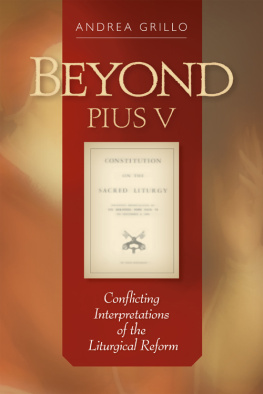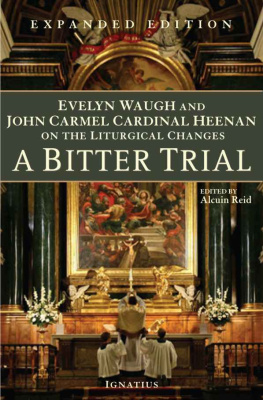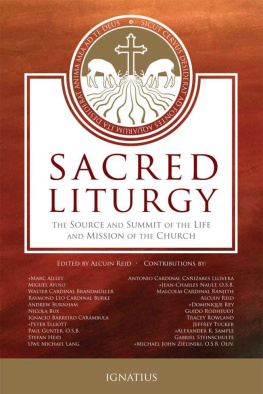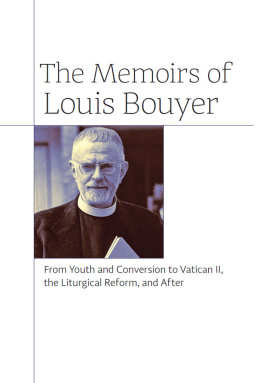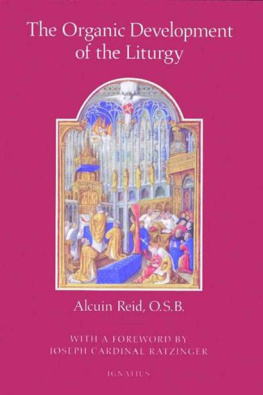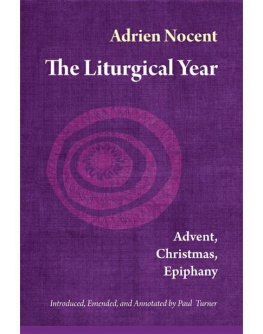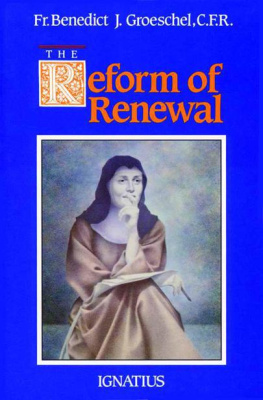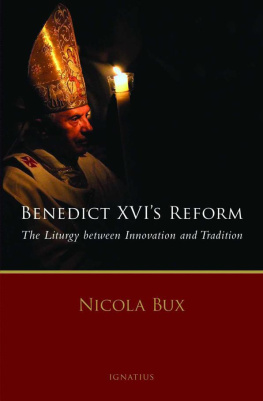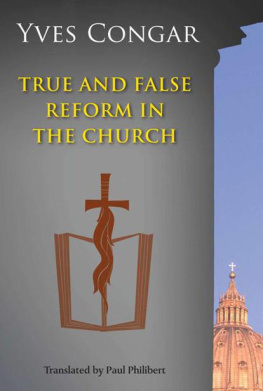This book recalls for us the fundamental motives that led, with great effort, to the liturgical reforms of Vatican II. It is a timely reminder of forgotten truths of the liturgical movement, namely, that it was and is a question not only of reforming the liturgical books but of forming Christians themselves through profound and conscious participation in the liturgical rites and prayers. It provides conceptual tools for a deep theological consideration of the intentions of the reform as well as a way of confronting the theological questions that necessary emerge from Benedict XVIs motu proprio Summorum Pontificum .
Jeremy Driscoll, OSB
Pontifical Athenaeum Sant Anselmo
Mount Angel Seminary
Andrea Grillo advances the debate on the liturgical reform with definitive evidence: despite the conflict of interpretations on Sacrosanctum Concilium and the motu proprio Summorum Pontificum of 2007, the theology of the liturgy of Vatican II remains a key part of the great and irrepressible reformulation of the churchs understanding of itself at Vatican II.
Massimo Faggioli
University of St. Thomas
In these five short but passionately written chapters, Andrea Grillo emphasizes how urgent it is to transcend the paralyzing polemics of recent years, provoked by reform of the liturgy, and to face with openness and determination the more fundamental but forgotten or as-yet-unknown aspects of the liturgical vision of Vatican II and of the early twentieth-century thinkers whose amazing insights prepared for it without intending to do so.
Barry Hudock deserves commendation for introducing one of Italys most prolific and highly respected theologians to the English-speaking world in such a clear and readable translation.
Patrick Regan, OSB
Professor Emeritus, Pontificio
Ateneo Sant Anselmo
Beyond Pius V
Andrea Grillo
Beyond Pius V
Conflicting Interpretations of the Liturgical Reform
Translated by Barry Hudock
Revised Edition
A PUEBLO BOOK
Liturgical Press Collegeville, Minnesota
www.litpress.org
A Pueblo Book published by Liturgical Press
Cover design by Jodi Hendrickson. Cover image: Wikipedia.
This book was originally published as Oltre Pio V. La riforma liturgica nel conflitto di interpretazioni , 2007 by Editrice Queriniana, Brescia, Italy.
2013 by Order of Saint Benedict, Collegeville, Minnesota. All rights reserved. No part of this book may be reproduced in any form, by print, microfilm, microfiche, mechanical recording, photocopying, translation, or by any other means, known or yet unknown, for any purpose except brief quotations in reviews, without the previous written permission of Liturgical Press, Saint Johns Abbey, PO Box 7500, Collegeville, Minnesota 56321-7500. Printed in the United States of America.
The Library of Congress has cataloged the printed edition as follows:
Library of Congress Cataloging-in-Publication Data
Grillo, Andrea.
[Oltre Pio V. English]
Beyond Pius V : conflicting interpretations of the liturgical reform / Andrea Grillo; translated by Barry Hudock. Revised Edition.
pages cm
A Pueblo book.
Includes bibliographical references.
ISBN 978-0-8146-6302-8 ISBN 978-0-8146-6327-1 (ebook)
1. Liturgical reform. 2. Liturgical movementCatholic Church. 3. Catholic ChurchLiturgyHistory20th century. I. Title.
BX1975.G7513 2013
264.02dc2
2013031501
To the great-grandparents and
great-grandchildren
of the liturgical reform:
that those who are no longer with us,
in communion with those who are not yet
with us,
may teach us
not only the unum necessarium
but also the quod superest.
Preface to the American Edition
More than five years after it was first published in Italian, Beyond Pius V now appears in English. The first Italian edition was published in May 2007, two months before the promulgation of Pope Benedict XVIs motu proprio Summorum Pontificum , based on hints and rumors about the coming document that had been circulating through Rome for many months. Now, with the hindsight of five years, it seemed necessary to update the text. The first four chapters here remain the same, with the exception of some minor revisions, and I have added a completely new fifth chapter, commenting on Summorum Pontificum (July 7, 2007) and the Ecclesia Dei Commissions instruction, Universae Ecclesiae (April 30, 2011). These two documents offer ample and objective confirmation of the concerns I raised in my original text. They make clear the need for an adequate hermeneutic of the Second Vatican Council and of the liturgical reform, to which theology can and must make an important contribution.
This book contributes to a discussion already in progress in the American context, particularly in two notable and recently published works. Massimo Faggiolis True Reform: Liturgy and Ecclesiology in Sacrosanctum Concilium and Patrick Regans skillful historical and theological study, Advent to Pentecost: Comparing the Seasons in the Ordinary and Extraordinary Forms of the Roman Rite , both offer important scholarly evidence that the Catholic Church of the third millenium ought to understand itself not according to Pius V or against Pius V but decidedly beyond Pius V. The fact that the same publisher now follows these two books with this English version of my own is surely a sign of the times worth noting.
Andrea Grillo
Rome
November 9, 2012
Dedication of the Lateran Basilica
Introduction
Nothing can ever happen twice.
In consequence, the sorry fact is
that we arrive here improvised
and leave without the chance to practice.
W. Szymborska
The reform of the liturgy is at risk. Indeed, at least in its most authentic and prophetic aspects, it now seems to be widely ignored.
Various developments, sometimes quite troubling, have sown doubts and confusion within the ecclesial community. The restoration of the Missal of Pius V and liberalization of the use of the preconciliar rite, demands from the highest levels for the use of a dead language, irresponsible and superficial comments offered publicly by important officials of the Roman Curia, unjustified crackdowns on the work of translators, an inversion of priorities between mystery and discipline, never-ending lists of abuses, and a dangerous disregard for the meaning of liturgical uses: these are only some of the signs of the serious threat that faces the ideas that have inspired and sustained the liturgical reform for nearly fifty years.
While church authorities certainly pay attention to liturgy, their interventionsdespite formal references to all the right documentsare out of tune with the foundational reasons for the reform. At the same time, it can be said that the quality of reflection carried on from the other side has also been inconsistent. Historical argumentsfrequently positivistic in natureare too often treated as the only kind that is legitimate or admissible.
The entire discussion is too often marked by biased presumptions, a sour nostalgia, and an antimodern and reactionary spirit, yet it is supported by surprisingly modern and ultraliberal arguments. It will suffice to mention, by way of example, the broad reintroduction of the Missal of Pius V, justified by an appeal to a freedom of rite that is offered with disregard for the unwanted consequences that such a development might bring in its concrete application. What might appear on the face of it to be a masterstroke of moderation risks becoming, more likely, a solemn mess for which no one is held accountable.
We can say, in fact, that while it may be hard to find many effective or serious attempts to attack the liturgical reform directly, it is no less difficult today to find defenses of the reform that dont amount to pretty much the same thing. Indeed, if there are enemies of the liturgical reform to speak of, they rarely attack it head-on. Insteadwith cunning and more than a little wordplaythey prefer to weaken the very terrain on which the reform stands. Reintroducing old meanings of participation in the liturgy or inventing new theories of freedom of rite, these authors suggest that the need for reform is long past, downgrade it to merely one possibility among many, and so effectively overcome it.
Next page
